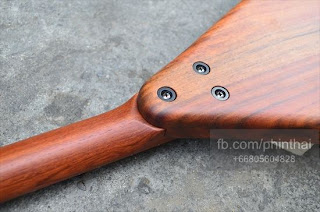http://www.atlasofpluckedinstruments.com/se_asia.htm
Thursday, April 11, 2013
Phin [Ethnic Guitar of Thailand]
The phin (pronounced “pin”) is a lute from Northeastern Thailand which usually has two or three metal strings and
a diatonic fretboard. Originally derived from the South Indian veena, it is far removed from its parent instrument,
looking more like a mandolin/dulcimer hybrid with a decorated dragon headstock. It was traditionally used for
vocal accompaniment, especially in courtship. Some modern phins are electrified and often played with distortion
and other effects (as used in the Isaan folk music of Northeastern Thailand and Laos). Depending on the tuning, the
frets can play hexatonic scales that are close to Dorian or Mixolydian modes, although in traditional tunings, some
notes are tempered differently from Western standards. The music has slight Chinese, Indian, and Indonesian
flavors, but a uniquely Thai groove and structure.
Shredding over a Drone
In typical phin music, one string is used as a repeating drone while the player shifts around the upper “melody” string, interspersing fast pull-offs and bouncing between open and fretted positions. The phin’s open strings are often tuned in 5ths, but 4ths are prominent in the tunes. Therefore, the B and high-E strings (the tonic and the 4th, respectively) are close enough in interval and range to approximate the phin sound.
Performance Notes
This sixteenth-note shuffle tune pulses like a palpitating heartbeat after a bite of hot green curry but manages to keep the carefree peacefulness of Thai music. It is built on repeated and varied phrases, using subtle changes in tonality to build interest.
Sawatdee Shuffle
You are now free to recall the conventional guitar wisdom that says a fast shuffle is best played “down–up, down– up,” with a downstroke for the long beat and an upstroke for the short beat. Imagine your hand moving in constant sixteenth notes while you pick selectively and “miss” the strings when not playing sixteenths. Don’t literally keep your hand bouncing all the time, but keep the groove in your mind. The down- and upstrokes are not strict either, just a general guideline for this kind of fast Asian swing.
Alternate picking is also important for bouncing between open and fretted notes on the E string. Notice that these moves are not done as hammer-ons and pull-offs but picked cleanly every time. You will get the chance to hammer and pull in other spots, notably the grace notes in measures 15 and 16.
Change of Mood
Notice the sudden appearance of a C# note (E string, fret 9) in measure 20—adding a 2nd to the relatively small number of notes in this tune and dramatically changing the direction of the piece. This is just one example of how a change in tonality over a drone, rather than a key change in a chord progression, can make a great impact.
Staccato Stings
You might have noticed the great number of staccato (dotted) notes in this piece. These are best nailed by taking your fret-hand finger off the fretboard—but not off the string—immediately after you pick the note, creating a percussive “sting” for extra energy.
Remember our favorite word, sul ponticello: pick close to the bridge for a tone with extra sting. This will also help you keep pitch control while you’re strumming heavily.
Shredding over a Drone
In typical phin music, one string is used as a repeating drone while the player shifts around the upper “melody” string, interspersing fast pull-offs and bouncing between open and fretted positions. The phin’s open strings are often tuned in 5ths, but 4ths are prominent in the tunes. Therefore, the B and high-E strings (the tonic and the 4th, respectively) are close enough in interval and range to approximate the phin sound.
Performance Notes
This sixteenth-note shuffle tune pulses like a palpitating heartbeat after a bite of hot green curry but manages to keep the carefree peacefulness of Thai music. It is built on repeated and varied phrases, using subtle changes in tonality to build interest.
Sawatdee Shuffle
You are now free to recall the conventional guitar wisdom that says a fast shuffle is best played “down–up, down– up,” with a downstroke for the long beat and an upstroke for the short beat. Imagine your hand moving in constant sixteenth notes while you pick selectively and “miss” the strings when not playing sixteenths. Don’t literally keep your hand bouncing all the time, but keep the groove in your mind. The down- and upstrokes are not strict either, just a general guideline for this kind of fast Asian swing.
Alternate picking is also important for bouncing between open and fretted notes on the E string. Notice that these moves are not done as hammer-ons and pull-offs but picked cleanly every time. You will get the chance to hammer and pull in other spots, notably the grace notes in measures 15 and 16.
Change of Mood
Notice the sudden appearance of a C# note (E string, fret 9) in measure 20—adding a 2nd to the relatively small number of notes in this tune and dramatically changing the direction of the piece. This is just one example of how a change in tonality over a drone, rather than a key change in a chord progression, can make a great impact.
Staccato Stings
You might have noticed the great number of staccato (dotted) notes in this piece. These are best nailed by taking your fret-hand finger off the fretboard—but not off the string—immediately after you pick the note, creating a percussive “sting” for extra energy.
Remember our favorite word, sul ponticello: pick close to the bridge for a tone with extra sting. This will also help you keep pitch control while you’re strumming heavily.
http://www.premierguitar.com/Magazine/Issue/2010/Dec/Thai_Phin_Drones_Re_creating_the_Sounds_of_Northeastern_Thailand_on_Acoustic_Guitar.aspx
http://www.youtube.com/watch?v=00YJH_4aB8A
http://www.youtube.com/watch?v=vEaIldMo_oA
http://www.youtube.com/watch?v=zl8hVjscPOU
Subscribe to:
Comments (Atom)





















































































